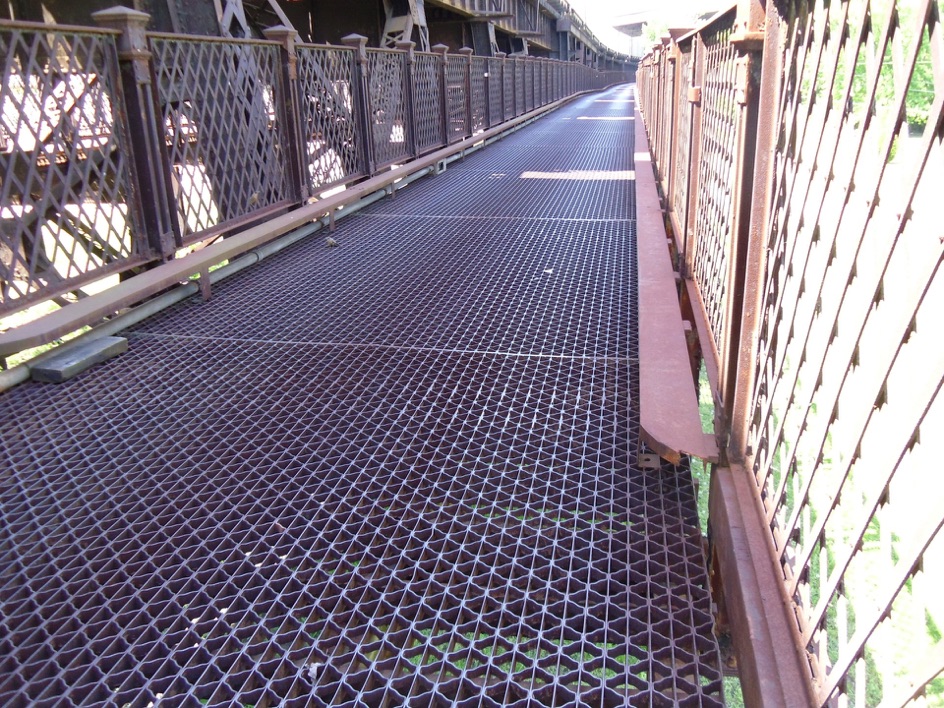
This photo tour was composed in early summer 2012 when members of CART began to focus on re-opening the underutilized roadways attached to the K&I railroad bridge. The idea however preceded the CART interest and had been pursued by Loop Trail planners in 2006 and likely before that. This is a good idea that is in the public realm and has many supporters.
The Bridge property is apparently owned in fee simple by the Norfolk Southern railroad. NS said in 2006 and repeated the statement to reporters recently in 2013, that concern for tort liability--big lawsuit damages for injured bridge path users--makes the reopening idea a ‘no go’.
Federal law includes provisions for shifting liability to a non-profit group that would agree to maintain and operate the cross river path, as well as pay insurance premiums and any taxes.
These laws usually apply where a rail corridor is actually ‘abandoned’ but the owner of the easement wants to keep other subservient property owners from reclaiming use of their property in the corridor, in case the railroad wants to reuse the line in the future. Many of these ‘Rails to Trails’ agreements have been entered with willing and cooperative railroads. See HERE and HERE
NS has not abandoned use of the K&I Bridge though it has discontinued the toll roads that were once a part of the bridge operation. Norfolk Southern has property ownership and control and continues to demand exclusive use of the K&I Bridge.
Light rail, bikeways, walkways?
Reopen K&I Bridge has many supporters


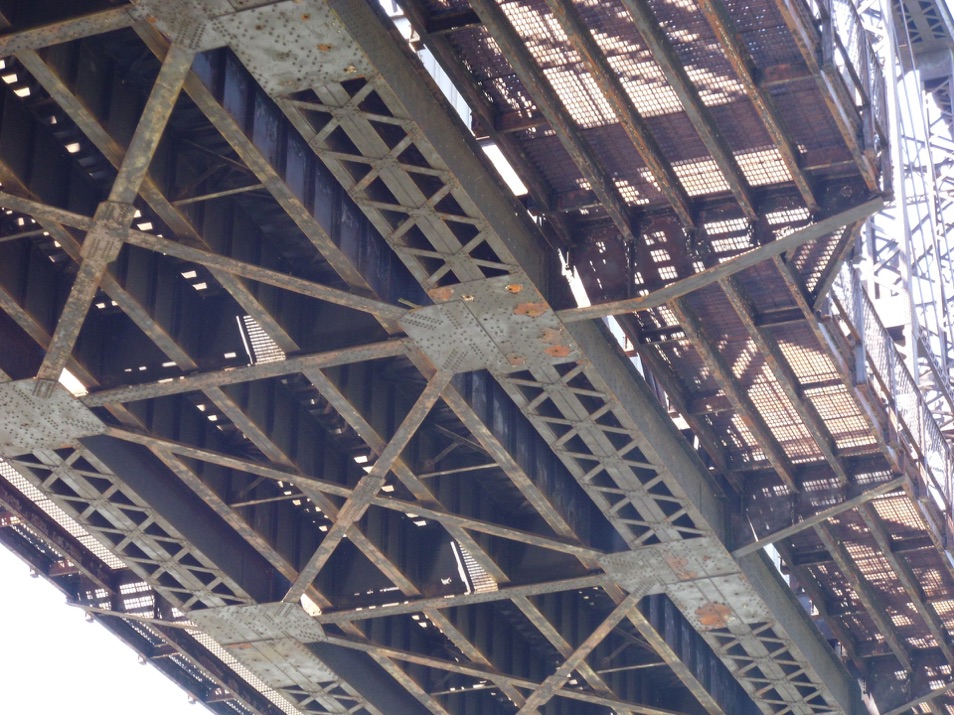

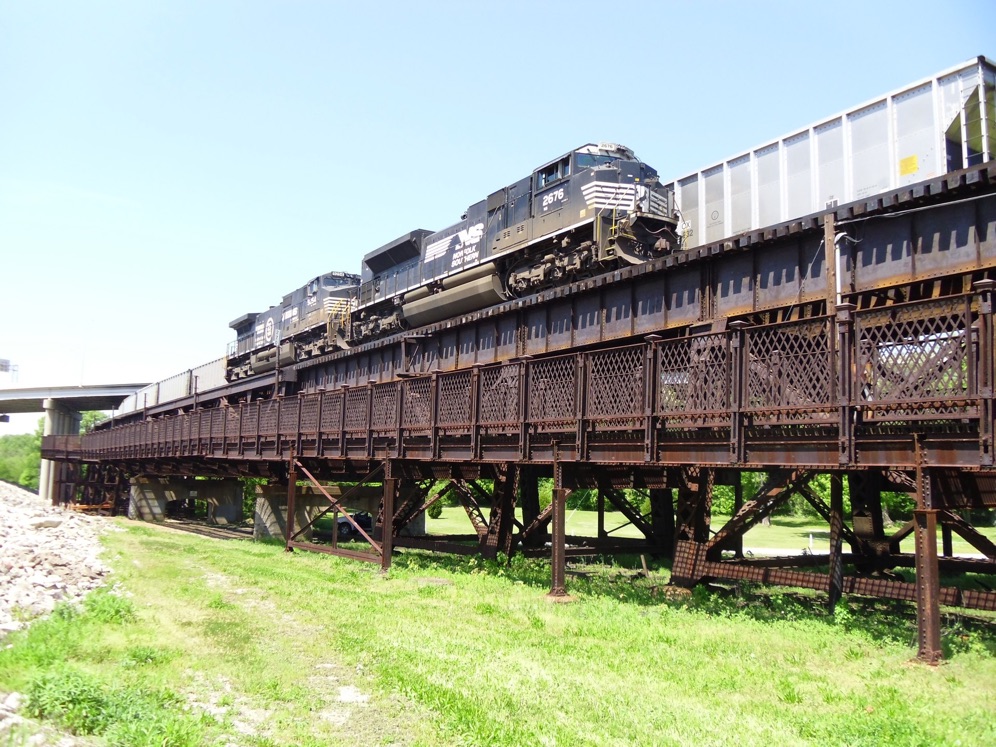
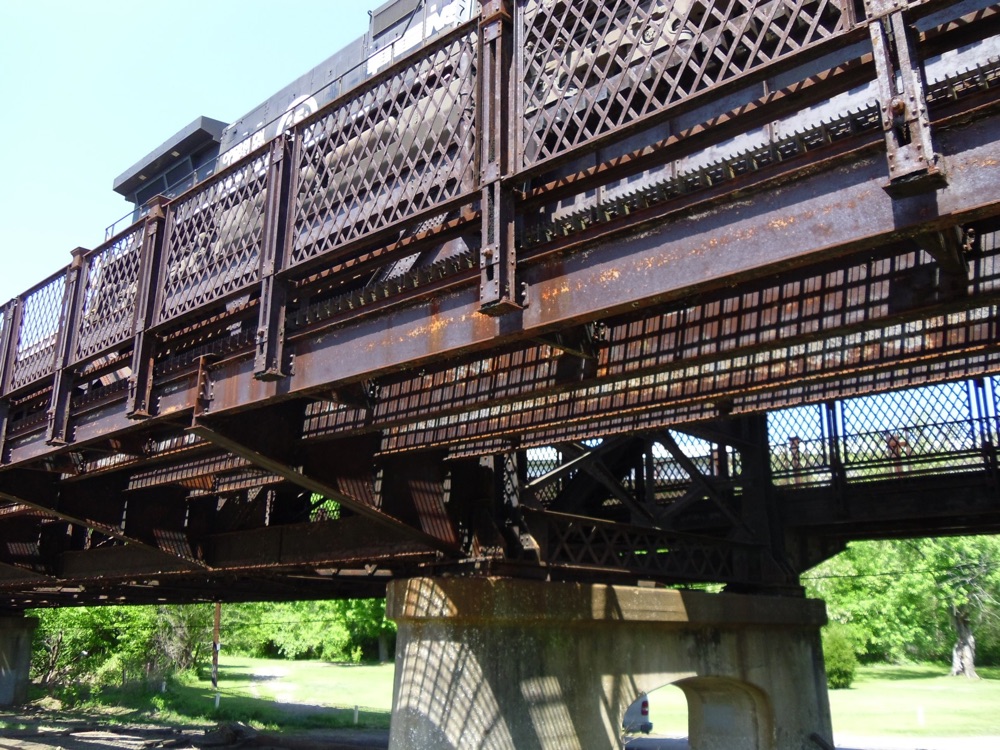
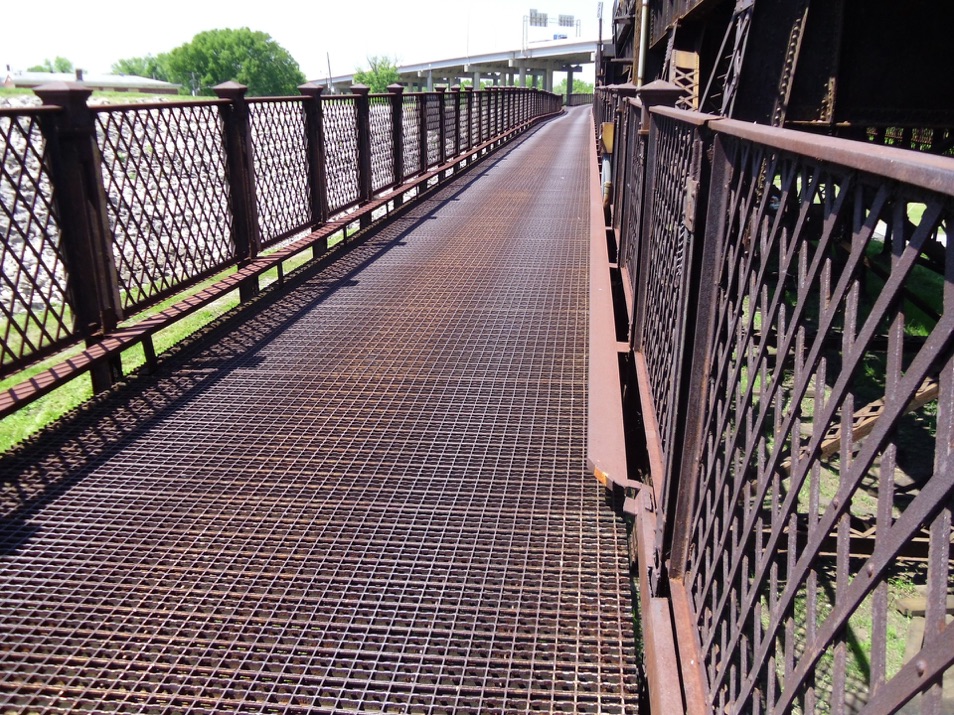
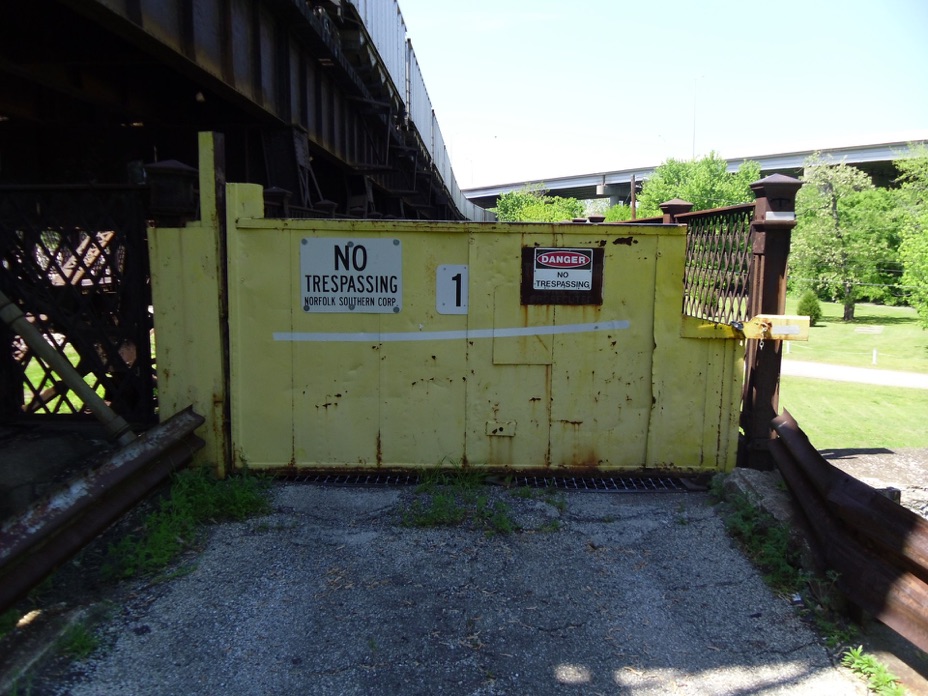


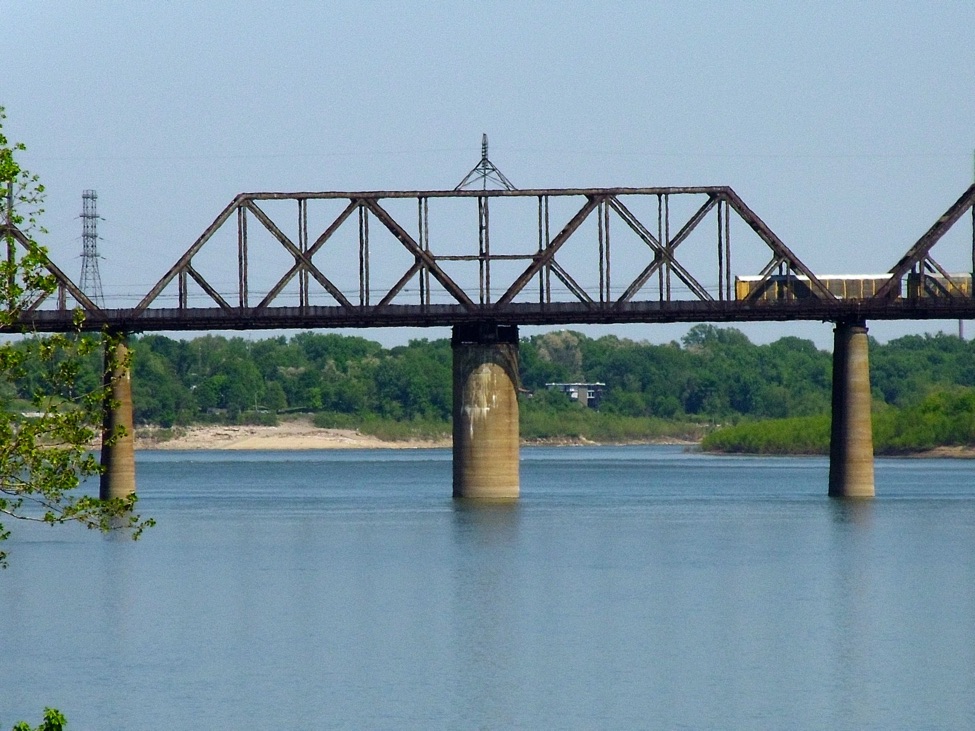
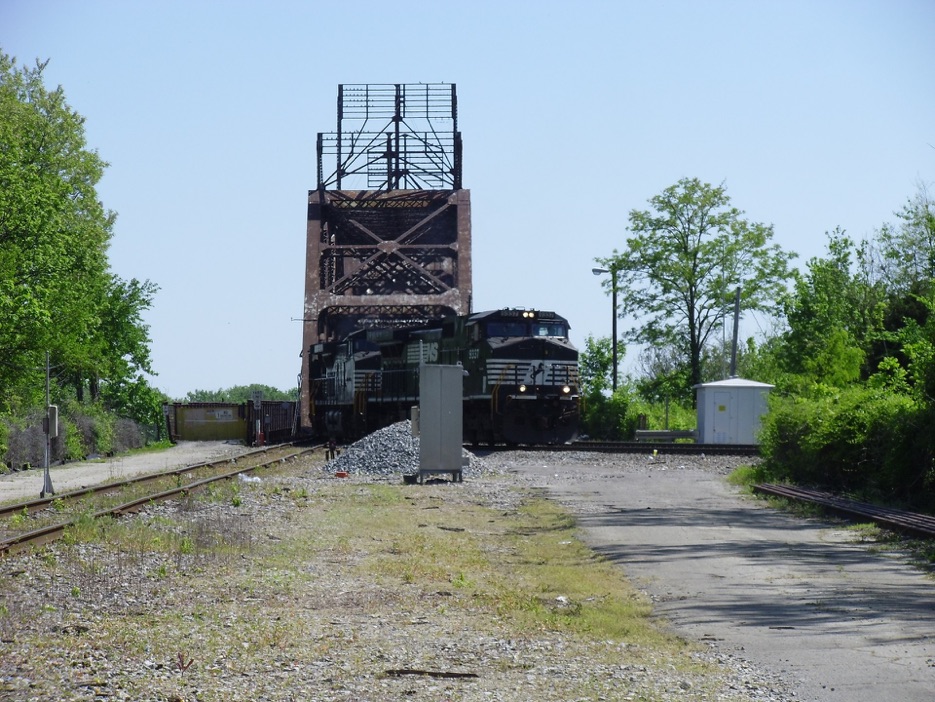
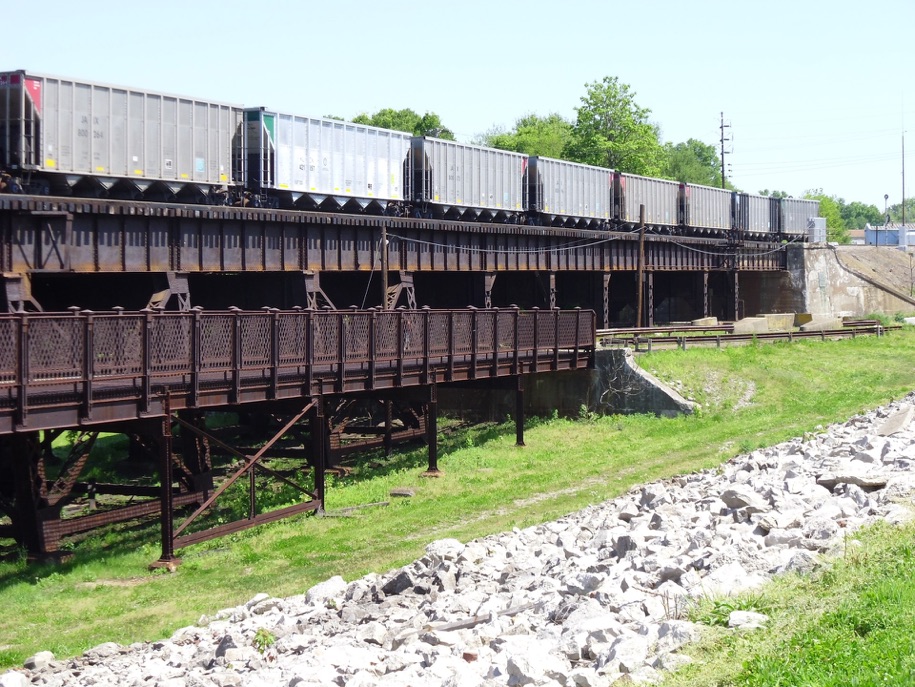
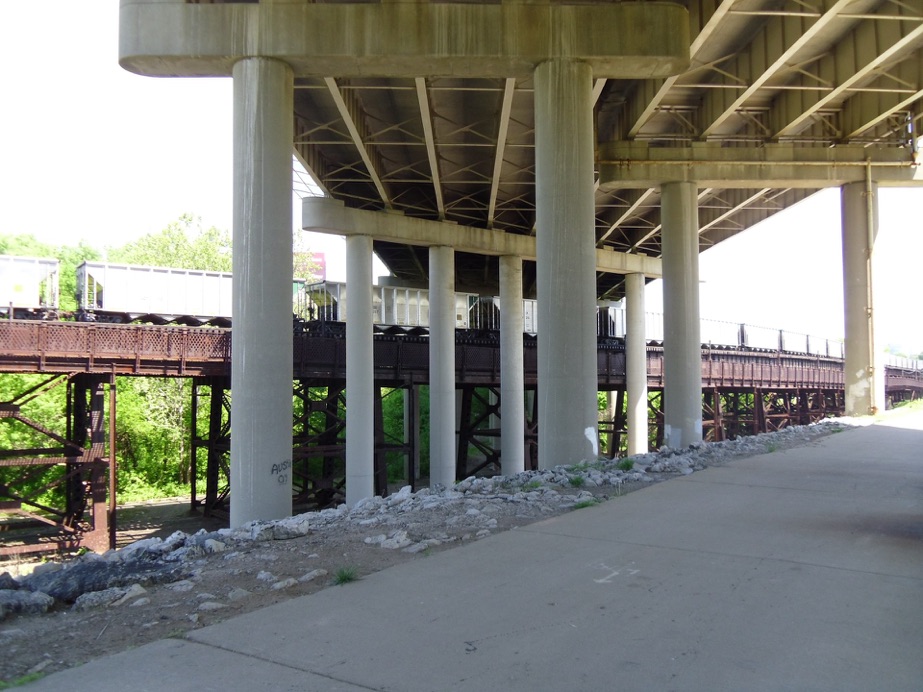
View looking towards Indiana along the closed traffic lanes shot from outside the gate
Above: Looking east from New Albany towards the McAlpine Lock
This section was originally built to rotate, to allow tall river traffic to pass, but then it was welded in place
Heavy freight use by Norfolk Southern railroad. The rail line is elevated above the vehicle lane level
Looking north down the second No. 2, closed lane at the gate
Bridge terminus at the Indiana side. Both rail lines cross the right side unused vehicle lane.
On the Louisville side the vehicle lanes do not conflict with the freight rail line
Considerable refurbishment of the narrow vehicle approach lanes may be required
Vehicle lanes are supported by outrigger beams from the rail bridge
View of the superstructure as it crosses the Ohio River
The steel mesh dispenses with steel reinforced concrete pavement --reducing weight


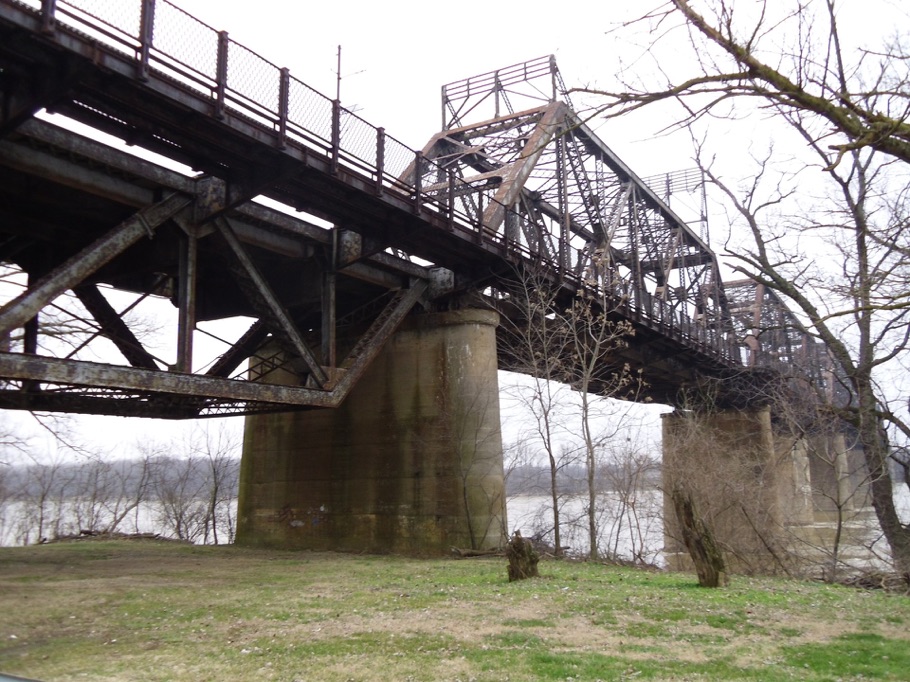
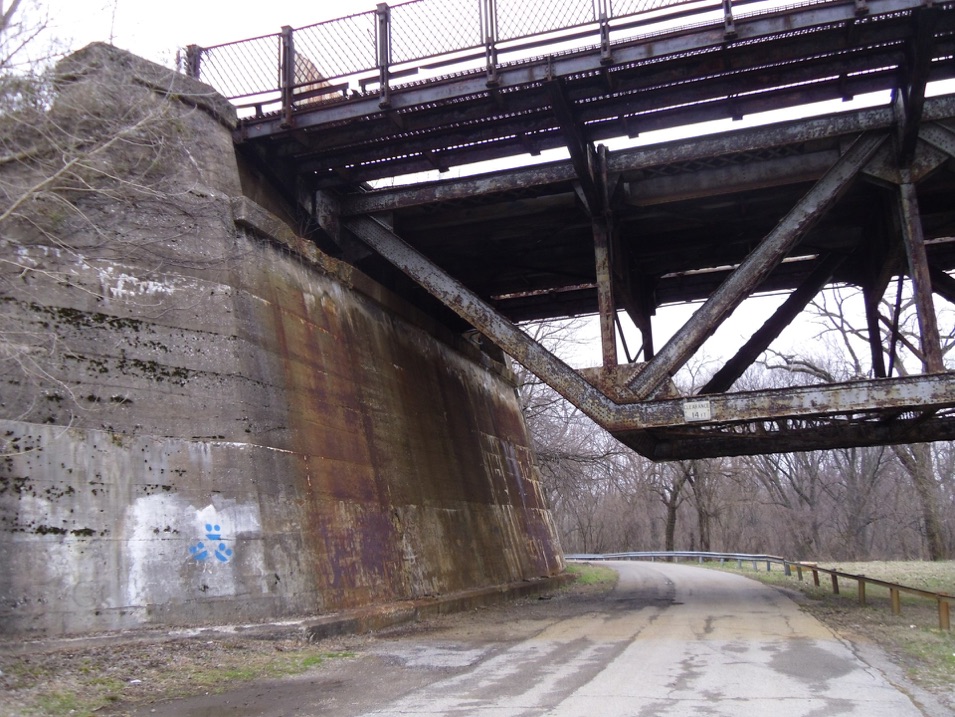

I-64 deck passes over the Louisville side of the K&I bridge
Despite a patina of age and rust, the iron structure still bears the weight of two rail lines of fully loaded rail cars
On the Indiana side a new access ramp could be built to allow constant traffic
Google aerial view of the Louisville terminus with the northeast lane passing under the rail line. There used to be toll booths here
Google aerial view of bridge terminus at the Indiana side. Both rail lines obstruct the right side vehicle lane.
Jurisdiction of the Surface Transportation Board over rail to trail conversion 49 USC § 10501 - General jurisdiction
(in relevant part)
(a)(1) Subject to this chapter, the Board has jurisdiction over transportation by rail carrier that is—
(A) only by railroad; or
(B) by railroad and water, when the transportation is under common control, management, or arrangement for a continuous carriage or shipment.
(2) Jurisdiction under paragraph (1) applies only to transportation in the United States between a place in—
(A) a State and a place in the same or another State as part of the interstate rail network;
(b) The jurisdiction of the Board over—
(1) transportation by rail carriers, and the remedies provided in this part with respect to rates, classifications, rules (including car service, interchange, and other operating rules), practices, routes, services, and facilities of such carriers; and
(2) the construction, acquisition, operation, abandonment, or discontinuance of spur, industrial, team, switching, or side tracks, or facilities, even if the tracks are located, or intended to be located, entirely in one State, is exclusive.
Except as otherwise provided in this part, the remedies provided under this part with respect to regulation of rail transportation are exclusive and preempt the remedies provided under Federal or State law.
(2) Except as provided in paragraph (3), the Board does not have jurisdiction under this part over—
(A) mass transportation provided by a local government authority;
The STB, as the federal agency with exclusive jurisdiction over abandonment of the right-of-way, is the only entity that could authorize any permanent use of the right-of-way under a Rails to Trails conversion agreement.
The most promising avenue is seeking a cooperative alliance with Norfolk Southern to obtain pathway access. The project had been estimated to cost $ 1.6 million in a 2006 review. Federal funds should be available for the alternative mode project as MAP-21 the re-enacted Transportation Bill has specific Section 1122 provisions:
‘‘(2) CALCULATION OF NATIONAL AMOUNT.—The Secretary shall determine an amount for each fiscal year that is equal to 2 percent of the amounts authorized to be appropriated for such fiscal year from the Highway Trust Fund (other than the Mass Transit Account) to carry out chapters 1, 2, 5, and 6 of this title.
‘‘(b) ELIGIBLE PROJECTS.—A State may obligate the funds
reserved under this section for any of the following projects or
activities:
‘‘(1) Transportation alternatives, as defined in section 101.
‘‘(2) The recreational trails program under section 206.
‘‘(4) ACCESS TO FUNDS.—
‘‘(A) IN GENERAL.—Each State or metropolitan planning organization required to obligate funds in accordance with paragraph (1) shall develop a competitive process to allow eligible entities to submit projects for funding that achieve the objectives of this subsection.
‘‘(B) DEFINITION OF ELIGIBLE ENTITY.—In this paragraph,
the term ‘eligible entity’ means—
‘‘(i) a local government;
‘‘(ii) a regional transportation authority;
‘‘(iii) a transit agency;
‘‘(iv) a natural resource or public land agency;
‘‘(v) a school district, local education agency, or school;
‘‘(vi) a tribal government; and
‘‘(vii) any other local or regional governmental entity with responsibility for or oversight of transportation or recreational trails (other than a metropolitan planning organization or a State agency) that the State determines to be eligible, consistent with the goals of this subsection.
‘‘(5) SELECTION OF PROJECTS.—For funds reserved in a State
under this section and suballocated to a metropolitan planning
area under paragraph (1)(A)(i), each such metropolitan planning
organization shall select projects carried out within the boundaries
of the applicable metropolitan planning area, in consultation
with the relevant State.

An interlocking decking module like the one shown here was laid down quickly for a pathway at the New Orleans Jazzfest. These modules can be made of recycled materials, plastic bottles and old tires.
Another competing idea is to explore laying rail trolley track on the cantilevered roadbed. The public transit track on the roadbed would not interfere with NS use of the freight rail tracks and could provide public transit connection from Downtown Louisville through Portland to New Albany and other points. One road bikeway/walkway == other roadway heritage trolley revival line connecting to a MSC -Market Street Connector line.
Global warming, climate change, bad urban air, the cost of gasoline and diminishing incomes are producing and will continue to produce a ground swell of support for revival of fixed rail public transit. A Heritage trolley line is a good first public transit starter project for Louisville which has sunk to a miserable level of public transit funding and ridership.
Though I tremble to say it, the ‘evil overlords’ who dictate what transportation infrastructure we fund, are missing the leadership boat. FORD Motor Company needs to re-invent itself as a builder of sustainable low carbon footprint urban transportation systems. Thats the future--and the future is yesterday.
Other social justice considerations would be served by building a Louisville public transit system on the Heritage Trolley revival concept, including building local trolley cars in the west end to provide jobs and restoring personal mobility to the unemployed trapped without reliable commuting connections in the west end. See Peace Train HERE
See Trolley HERE

Composite recycled rubber tires are priced in the neighborhood of
$ 8.50 /foot for 48inch width For a 10 foot length 8 feet wide the cost would be $ 85 X 2 = $ 170
6000 foot length of K & I Bridge divided by 10 feet - 600
600 X $ 170.00 = $ 102,000 to buy an 8 foot wide covering
we could buy a tire cruncher and use our own tires ???
Why we need transportation alternatives--See Peaks of Conductivity HERE
Welcome Page BadwaterJournal HERE

The other railroad bridge - the 1868 Fourteenth Street Bridge seen here at the Falls of the Ohio, has no vehicle lanes Wikipedia article HERE

Fourteenth Street Bridge at the McAlpine Lock with the vertical lift span raised to let a tall barge pass beneath

31st and Northwestern Parkway in Portland where the K&I makes landfall. view is looking west down Montgomery Street

First page of multipage 1981 Deed for conveying ownership of the K&I Bridge to Southern Railway -later merged with Norfolk Southern.
NS would eventually control all the property in the hands of various property owners who had a piece of the K&I and adjacent lands. I conclude that Norfolk Southern does not simply have a rail easement across the bridge but owns it in fee simple. NS use of the bridge for its freight rail operations is subject to regulation by the Surface Transportation Board. It has maintenance and operation duties enforced by the STB. Various legal theories have been floated as to how to compel NS to open up the roadways. Case law from other jurisdictions is informative.
Beatty v. Louisville & Nashville Railroad Company, 195 S.W. 487 (Ky.App. 1917)
It has with uniform consistency been held by this court that a private citizen has no vested right in the permanent continuance of a public highway for a discontinuation of which he might maintain an action either for damages or to enforce a perpetual maintenance of the highway.
"A private citizen has no right of property in a public road, although it passes over his own land, unless he owns the land itself subject to the easement. If the owner of land abutting on a public road has a right of property in the easement, it necessarily follows that no change or alteration can be made without first making compensation to the owner (over whose land the change would run), as it would be a taking of private property for public use without compensation; but he has no other interest except such as is common to the entire public, and, where he is the owner of the land and the road is discontinued, its use then reverts to him to the extent he has title, but no further."